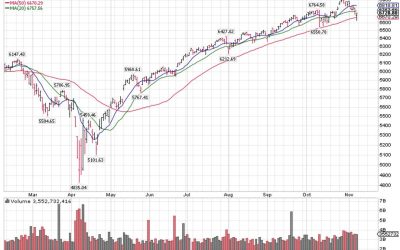by Gary Alexander
July 1, 2025
Two centuries ago, in 1825, New York’s Erie Canal opened, but it was already archaic technology. Railroads were just entering America’s industrial tool kit after being born in Britain in the early 1820s.
In fact, the Brits were already facing their first technology- stock crash 200 years ago this month, in July 1825.
The First High-Tech Stock Market Crash was 200 years Ago … in British Railroad Stocks
In 1825, the information highway had iron rails, in Britain at least. In 1824 and 1825, prospectuses were issued for 624 railroad companies, so in early 1825, the famous London merchant banker Francis Baring declared that “a gambling mania has seized upon all classes and is spreading in all parts of the country.”
In its March 1825 issue, The Quarterly, a London publication, also proclaimed, “Nothing now is heard of but the railroads. The daily papers teem with notices of new lines in every direction; pamphlets are thrown before the public eye recommending nothing [else] throughout the Kingdom.”
This high-technology market bubble predictably topped out in July 1825 in England, and many companies were in stock liquidation by late 1825, when the first British commercial railroads began operations. (Source: Barron’s, “Net Destinies: Remembrance of bubbles past foreshadows the fate of this one,” June 28, 1999).
Meanwhile, across the ocean, after America prevailed in two wars of Independence with Britain (the second in 1812), we trailed Britain in technology, with many frontiers to conquer. The proposed Erie Canal would link the Hudson River to the Great Lakes, in a series of locks 363 miles long, falling 555 feet in 83 locks. It was 40 feet wide and only four feet deep and was dug out entirely by hand.
On the nation’s 41st birthday, July 4, 1817, New York Governor DeWitt Clinton turned the first shovelful of dirt on that great undertaking, one of the great early NYSE-funded efforts in nation building. At the time, everyone thought the canal would take decades to build, but that Clinton politician of old sounded like JFK in 1961 when he said, “The day will come in less than 10 years when we will see Erie water flowing into the Hudson.” Like our 1960s moon shot, the finished canal happened in eight-years.
America’s new stock market helped kick-start that tech boom, as the building of the Erie Canal created a mania in canal securities, generating capital inflow from Europe. When opened in late 1825, the Canal was quite profitable, but canal digging was no way to transport raw and manufactured goods over the long distances of an expanding nation. After the Civil War, railroads began to proliferate, along with hundreds of bridges spanning rivers to deliver the goods across America. As with many other industries, the Panic of 1873 – which lasted for until 1878 – interrupted this growth, but the 1880s were boom years.
In fact, it was on July 3, 1884, that journalists Charles Dow and Edward Jones published their first stock price index. That first index was mostly composed of railroads, the dominant sector at the time. (The Dow Jones Industrial index was not launched until 1896, and it was also dominated by railroads).
Recommended Book: “The Spans of North America”
(Photos and text by David Plowden, 1974, revised in 2002)
“Make no little plans. They have no magic to stir men’s blood.”
– Architect Daniel Burnham
Bridges were essential for long-haul rail traffic. One of hundreds of examples in “Bridges: The Spans of North America” is the Poughkeepsie Bridge over the Hudson, begun in 1873 but not finished for 17 years due to the 1870s Panic. Its span ran over a mile (6,767 feet) at very high elevations. Under the river’s surface, engineers had to dig 130 feet below low tide – 60 feet of water plus 70 feet of mud and clay.
They call Pittsburgh the city of bridges (below, right). According to David Plowden in the 2002 update to his book on Bridges, “Today, Pittsburgh boasts more than 1,500 bridges” (p. 169); here are five of them:
American History Can be Told in Terms of Each Dominant Technology
We measure population cohorts as the Greatest Generation, Boomers, Millennials, Gen-X and so forth. We might as well measure our nation’s history in generations of technology. We don’t invent everything first, but we do spread new knowledge far, wide and fast, to advance the productivity of each generation.
As July 4th approaches this coming Friday, and we start our 250th year as a nation, it’s helpful to recall how primitive our technology was in fighting for independence. Specifically, Washington took control of the Army this week 250 years ago but had little power or cohesion in his army and was in retreat for most of the next six years. On July 3, 1775, General George Washington arrived in Cambridge, Mass., to take charge of the new “United States Army,” but he found only a rag-tag mob of 12,000 unruly soldiers, with another 5,000 sick or wounded from the recent battle on Breed’s Hill. An added challenge was that New Englanders were unsure they would follow a Virginian into battle. An even bigger challenge was money:
On the monetary side of the struggle, Continental currencies were issues in May and June of 1775 (left, below). On July 25, Maryland issued a $1-1/3 bill depicting George III trampling on the Magna Carta (right) but by 1779, America suffered its worst inflation in its history and General Washington moaned that worthless Continental: “A wagon-load of currency will hardly purchase a wagon-load of provisions.”
Graphs are for illustrative and discussion purposes only. Please read important disclosures at the end of this commentary.
Graphs are for illustrative and discussion purposes only. Please read important disclosures at the end of this commentary.
Turning to the dominant technologies of the day – in 50-year cycles – Britain began ahead of us:
1825: Railroads and the industrial revolution dominated Britain, as America built the Erie Canal
1875: Railroads began to dominate America, as reflected in most early stock market indexes.
1925: Automobiles began to push trains aside, while radio dominated mass communications.
1975: Computers in business, and soon personal computers, began to transform businesses.
2025: Artificial intelligence (AI) begins to dominate business practices, boosting productivity.
This market map gives us a rough approximation of the dominant technology in each generation:
Graphs are for illustrative and discussion purposes only. Please read important disclosures at the end of this commentary.
Just as railroad stocks crashed in Britain in 1825, so they crashed in America in the 1870s and again in the 1890s, but they kept growing throughout the 1800s (reflected in blue, above). Then came cars, industrials and materials, computers, hardware then software and information tech, in waves of creative destruction.
But stocks went nowhere in several odd decades, like the 1890s, 1930s and 1970s. Few businesses could survive the choking off of liquidity by the Federal Reserve in 1930-32 – the greatest cause of The Great Depression. Starving for cash, Americans soon began starving for food and shelter some 90+ years ago:
In 1932, 25% of American workers were unemployed, and another 25% were severely under-employed. Wages (for those who worked) were 60% below 1929 levels. Stock dividends were 57% lower than in 1929, and the GDP had shrunk in half. The stock market reached its 20th century nadir on July 8 but on July 2, 1932 (a Saturday), Franklin D. Roosevelt became the Democratic nominee for President, and the stock market began to come off its lows. After reaching its 20th Century low of 41.22 on Friday, July 8, the Dow Jones index rose 26.7% in the rest of July 1932 and gained almost five-fold by 1937, to 194.4.
As bad as things may seem today, when people compare today to the 1930s, they reveal gaps of ignorance about our history, but the great lesson is that America bounces back and creates great fortunes yet again.
P.S. America’s two highest bridges (above the river) are in my home state of Washington, in Mason County, near Shelton, 22 miles Northwest of Olympia, the state capital – both built in 1929 for loggers.
The post 7-1-25: Technology Has Always Been High-Risk and High-Reward appeared first on Navellier.












